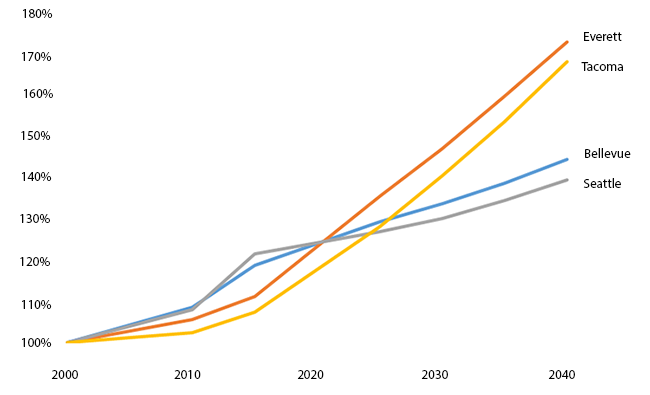Our Improbable Growth Targets

Regional projections indicate a sharp slowing of growth in Seattle and Bellevue, while Tacoma and Everett accelerate (year 2000 population=100%).
Recent Census data showed another year of strong growth in Seattle and Bellevue. Everett and Tacoma grew more slowly. This raised a familiar question: why are regional plans so out of step with recent experience? Seattle grew 2 1/2 times faster than either Everett or Tacoma in the last five years. Bellevue and other cities on the Central Eastside are also developing quickly. What would cause a reversal of these trends so that Tacoma and Everett can grow into their ambitious 2040 goals?
Regional growth plans are a mix of forecasting and policy-making. The State Office of Financial Management produces state and county forecasts. OFM population forecasts determine targets for housing growth, which are apportioned between cities by PSRC and county planning processes. In each county, the largest 'Metropolitan' cities (Seattle, Bellevue, Tacoma and Everett) are allocated a portion of the anticipated growth. Other cities are allocated lesser shares of expected growth, as are unincorporated areas within the Urban Growth Area (UGA). Few unincorporated urban areas remain within King County, but many fast-growing suburbs in Pierce and Snohomish are unincorporated. Lower targets are set for rural areas outside the urban boundary.
The median housing target sets the floor for zoned capacity. Cities and Counties must zone for sufficient developable capacity. Some cities zone for greater capacity than required; others do the minimum to stay in compliance. Much planned development is within Regional Growth Centers.
Benchmarking recent data against the PSRC's Land Use Vision puts the forecasts in context.
Pierce and Snohomish Counties have grown faster than King for decades. But King County recovered more quickly from the recession. Maybe it's premature to conclude the 'normal' suburban growth norm won't reassert itself. But other center cities in the US are also outpacing their suburbs. If the flight to the suburbs is really over, should we expect King to lag its neighbors in the future?

State forecasts are for Pierce and Snohomish County to outpace King, in a reversion to historical norms of faster growth in the suburbs.
King County, having recently outpaced forecasts with urban-focused growth, is expected to revert to the mean. Some of the reversion is just bureaucratic inertia as complex multi-jurisdictional planning processes play catch-up. The 2040 forecast implies a slowdown across King County with just 0.55% average growth over the next 25 years. That compares unfavorably to the 1.85% average countywide, and 2.4% in Seattle, observed over the last five years. This slow pace would restore the past balance between the counties.
Growth is to slow slightly in Pierce and Snohomish, but will outpace King County. Pierce and Snohomish planners are predicting dramatic changes in how their counties grow.
Growth will shift to the Metro cities (the steeply rising blue lines below). Both Everett and Tacoma have lagged behind neighboring suburbs. No longer. Everett and Tacoma are to grow much faster than their neighbors. Tacoma is to grow 1.8% per year, even as other urban areas in Pierce grow 1.1% and rural areas not at all. Everett's planned growth of 1.9% through 2040 is more than twice the rate planned elsewhere in South Snohomish.
Put another way, Everett is allocated 30% of Snohomish growth through 2040, vs 7% in the last fifteen years. 45% of Pierce County's growth would be in Tacoma, vs 10% in the last fifteen years.

2040 projections indicate a slowing in King County, and a radical re-balancing toward urban growth in Tacoma and Pierce.
Growth of 1.8% per year over 25 years would bring a far-reaching urban renaissance in Tacoma and Everett. Perhaps urban amenities and a lower cost of living can combine to drive such growth, but it is a dramatic break from trend. The reversal of recent rapid growth in Bellevue and Seattle would be a significant break in trend in the opposite direction. The combination of circumstances seems unlikely.